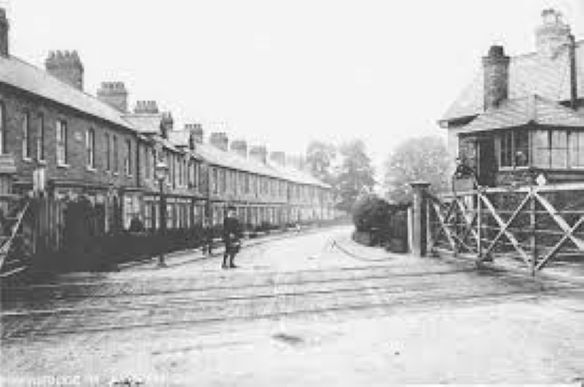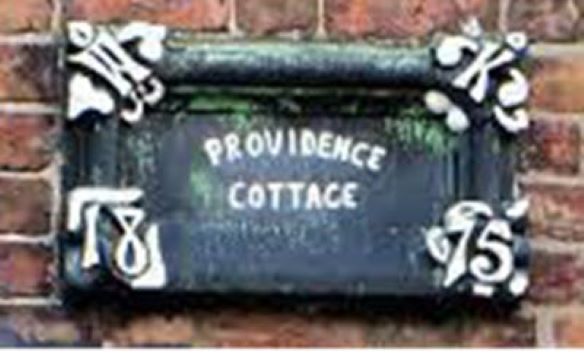An example from the 2016 Research Journal
Wesley Knowles
by Susan Church
By the second half of the 19th century the railway industry was well established with thousands of people in its employment, both in day to day operation and the associated railway works. However the health and safety record was not good and many accidents occurred resulting in death or the loss of a limb. With no state benefits or compensation schemes in place injured rail men had to find alternative employment and one job which could be carried out by a man who had lost an arm was that of railway crossing keeper.
There is some confusion about the early life of Wesley as he was also known as James Yells. As Wesley Knowles his birth was registered in Herefordshire in 1839 but this name does not appear in the census returns in 1841, 1851 or 1861. James Yells does appear in the census, firstly as the son of a gamekeeper (also called James Yells) and then in 1861 lodging with an elderly shoemaker in Hereford where he described himself as a “railway official”. In 1865 whilst working as an engine driver (according to one report, although a later account suggests that he was a signalman) the young man suffered an accident which resulted in the loss of an arm, and on his recovery he was sent to Nantwich to act as crossing keeper at the Shrewbridge Road crossing. By the time of the 1871 census he was lodging in Millstone Lane with Sarah Warburton the wife of plasterer James Warburton. Recently widowed, Sarah had a grown up son and a young nephew living with her and no doubt the extra income from a lodger would be very welcome. A 24 year old daughter Mary was living at 8 Dysart Buildings where she worked as housemaid for John S Nixson, a well to do shoe manufacturer employing 120 hands.
In 1872 Wesley married Mary Warburton in a nonconformist ceremony and the couple moved into a railway cottage close to the crossing. By November 1874 the couple had a son, John, and Mary was expecting her second child. On Friday 20th November Wesley was on duty and had seen the 6.20pm train go through, after which he opened the gates in order to allow some traffic through. According to a report he would normally have closed the gates again but for some reason on this occasion he did not.
At one minute to seven o’clock he received a message from Market Drayton Junction to indicate that a Great Western train was approaching from Market Drayton. Instead of going out immediately to attend to the gates he paused to enter the time in his log book and then ran out to shut the gates. He had got the up-line gate back in position but the down-line gate was only half way back when the train thundered through, smashing the gate in half.
When the train pulled up at Nantwich station the remains of the gate were still stuck to the front of the engine. Local printer Thomas Johnson was on the platform talking to the stationmaster and the two men ran back along the line to find Wesley on the track some distance from the crossing. He was lying between the metal tracks, badly cut and bruised and suffering from concussion and a broken collar bone. Sadly his remaining arm had been caught above the elbow by the wheels of the train and was partially severed. It was said that his life was only spared because before the train passed over him he had been thrown into a hollow or gutter which crossed the track, and in fact on the following day it was noticed that some of his hair was stuck to the track indicating how close to death the man had been.
The stationmaster and Mr Johnson carried the semi-conscious man into his house and sent for the doctor. Mr Matthews, a local surgeon, and Dr Munro arrived quickly and set Mr Johnson to sit on the patient whilst they removed the damaged arm and tied the arteries, returning the next day to complete the operation. The rest of the arm was removed near the shoulder leaving a small stump similar to the other side. For two days it seemed that there was little hope of survival but on Monday Wesley passed a quiet night and it seemed as though he might pull through. It was noted, however, that “if he lives he will be perfectly helpless, and seeing that he has a child, and a wife very near her confinement, the case is sad indeed.”
The report concluded that the gates at Shrewbridge crossing were frequently damaged in this manner, although no other injuries were cited, and it was suggested that the rail company should change the operation of this crossing to the system already in place at the London Road crossing, whereby the gates were operated by a system of levers from the signal box which also controlled the distance signals and indicated whether the line was clear or not.

One week later the local Guardian newspaper reported that: “The poor man Knowles, who was deprived of his remaining arm by the accident at Shrewbridge Lane level crossing, though in great pain, is going on favourably and will probably ultimately recover. He will however in that case be an utterly helpless cripple, unable to earn a livelihood, so that the maintenance of the household will depend on his wife, who is expecting very shortly an addition to her family. These circumstances make the case very sad, and have excited much sympathy in Nantwich. A subscription is about to be raised in the town on behalf of Knowles, and it is hoped that a sufficient sum will be raised to place Knowles and his wife in some small way of business. His friends are quite poor and he has no other hope of subsistence than this. Knowles has always been a civil and worthy man, and we trust our Nantwich readers will come forward generously in aid of so deserving an object of public charity.”
The townspeople were greatly moved by the plight of the young family and the Knowles Relief Fund was set up, organised by Mr Samuel Harlock, draper, Mr Hains, a railway worker, and Rev Payne the Congregational minister (Wesley was a committed Congregationalist). Books were set up in numerous shops and factories and everyone gave what they could afford. By January 1875, just six weeks after the accident, the books of subscription were closed and the sum of a little over £70 was deposited at the District Bank. It was decided that there was enough money to build a house and shop on land facing the Barony, plans were speedily passed by the Local Board and building commenced of the aptly named Providence Cottage. Following the building of the property there was enough money left in the fund to purchase an artificial limb so that Wesley would at least be able to feed himself. The family soon settled down into their new way of life, assisted by a young female servant. Mary would work in the “tea-cake and grocery shop whilst Wesley would walk around the town with a basket strapped over his shoulders and people would take their goods and put the money in a little tin kept for the purpose.
In the following years more children arrived, with six surviving to adulthood (one son Ernest died in infancy), and the older ones gradually started to help in the shop. Thus the little family thrived due in part to the generosity of the townspeople.
Wesley Knowles died on Tuesday 17th March 1925 aged 85, Mary having pre deceased him in 1913. The account of his death in the local newspaper also mentioned that since the accident Mr Thomas Daniels, now a retired hairdresser, had looked after Mr Knowles’ hair free of charge for over 40 years. Wesley was described as one of the most regular attenders at the Congregational church and many of the church elders attended his funeral. The pastor Mr Lee conducted a service at the house for the children and grandchildren of the family and deacons and other officers of the church. They were then joined at the General Cemetery by many friends of the family and other members of the church for the committal service. Amongst the wreaths was one from the deacons of the church.

There is a small and simple headstone at the Cemetery, but his memory also lingers on in a plaque on the house with his initials and the date of building named Providence Cottage. Following the building of the property there was enough money left in the fund to purchase an artificial limb so that Wesley would at least be able to feed himself. The family soon settled down into their new way of life, assisted by a young female servant. Mary would work in the “tea-cake and grocery shop whilst Wesley would walk around the town with a basket strapped over his shoulders and people would take their goods and put the money in a little tin kept for the purpose.
In the following years more children arrived, with six surviving to adulthood (one son Ernest died in infancy), and the older ones gradually started to help in the shop. Thus the little family thrived due in part to the generosity of the townspeople.
Wesley Knowles died on Tuesday 17th March 1925 aged 85, Mary having pre deceased him in 1913. The account of his death in the local newspaper also mentioned that since the accident Mr Thomas Daniels, now a retired hairdresser, had looked after Mr Knowles’ hair free of charge for over 40 years. Wesley was described as one of the most regular attenders at the Congregational church and many of the church elders attended his funeral. The pastor Mr Lee conducted a service at the house for the children and grandchildren of the family and deacons and other officers of the church. They were then joined at the General Cemetery by many friends of the family and other members of the church for the committal service. Amongst the wreaths was one from the deacons of the church.
There is a small and simple headstone at the Cemetery, but his memory also lingers on in a plaque on the house with his initials and the date of building